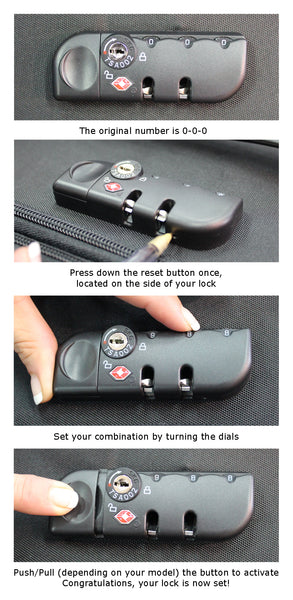Luggage & RFID FAQs
LUGAGGE CARE
How to care for your luggage?
Gabee Products Group designs and distributes a wide range of luggage under our own brand Cobb & Co as well as iconic National Geographic and Echolac hardside and softside luggage.
These leading luggage brands enjoy world wide recognition synonymous with quality, style, dependability and innovation in light weight luggage and travel accessories.
Ensure the long life of your luggage by following these simple guidelines:
Hardside Care
To clean hardside luggage, we recommend using a gentle soap and warm water, rinsing well. If you would like to wax the case after cleaning, any good silicone-base automobile or furniture polish will preserve the luster and add resistance to the covering.
Softside Care
To clean softside luggage, we recommend spot cleaning with a mild soap/ detergent and water. If this is not uccessful, try a spot removal product or use a foam type cleaner used to clean car mats.
Storing your Product
Extremes of temperature, as well as the extremes of humidity and moisture will tend to age luggage. Never store luggage in a plastic bag and let it 'air' when storing away to prevent mildew from forming as a result of humidity and damaging the case.
LUGGAGE & TSA BUILT IN LOCK INSTRUCTIONS
What is A TSA lock?
TSA locks are required for all customers travelling to the USA. The American Transport Security Administration (TSA) screens every passenger's baggage before it is placed on the plane. At their discretion, from time to time, they choose to open a passenger's luggage for closer inspection. As part of this process, some bags are opened and physically inspected. If the TSA officer was unable to open your bag because it was locked, the officer may be forced to break the locks on your bag. If you have TSA approved locked the officer will use a master key to open locks and inspect case. Note our site will clearly state which luggage pieces are clearly fitted with TSA locks.
About:
The American Transport Security Administration (TSA) is required by law to inspect all checked baggage. As part of this process, some bags are opened and physically inspected. If the TSA officer was unable to open your bag because it was locked, the officer may be forced to break the locks on your bag. If you have TSA approved locked the officer will use a master key to open locks and inspect case. Note our site will clearly state which luggage pieces are clearly fitted with TSA locks. The above laws are applicable in the USA only.
How to set a TSA lock?

-
Q- My lock did not come with a key?
A- You do NOT receive a key with TSA locks. The Keyhole on your TSA lock is for TSA personnel ONLY. It allows them to open, inspect and re-lock luggage if necessary. This applies to passengers arriving and/or connecting to the United States. -
Q- I forgot my lock combination, how can I open my lock?
A- You cannot reset your lock combination without knowing the original combination you had set. You can buy bolt cutters to break open your lock - but there is another more simple solution if you have 15 minutes to spare. Simply try all the possible combinations from 000 - 999 ( 000, 001, 002, 003 through to 999) It may sound like a tedious task, but it should only take you 15 minutes to go through all the numbers - and it will save you from breaking your lock. So its the best solution if you forget your combination code. Try it out instead of breaking your lock and having to buy a new one. -
Q- What is the benifit of a TSA lock?
A- This applies to passengers arriving into the USA and connecting to other flights, the Transportation Security Administration (TSA) requires access to air passengers' luggage for security screening in the USA, sometimes without the passenger being present. To allow luggage to be locked for protection against theft, the TSA has approved certain locks, identified by a logo on the locks. TSA personnel can open and inspect your luggage and then relock your luggage with these TSA locks as they have special tools specific to TSA Locks in order to do so. If TSA screeners need to inspect your luggage and you do not have a TSA Lock, then they may break your Lock to inspect your luggage and then from that point on, your luggage will remain without a lock, rendering the lock you originally placed on your luggage, useless.
WHAT IS RFID?
A- Radio-frequency identification (RFID) is the wireless use of electromagnetic fields to transfer data, for the purposes of automatically identifying and tracking tags attached to objects. There are several methods of identification, but the most common is to store a serial number that identifies a person or object, and perhaps other information, on a microchip that is attached to an antenna (the chip and the antenna together are called an RFID transponder or an RFID tag). The antenna enables the chip to transmit the identification information to a reader. The reader converts the radio waves reflected back from the RFID tag into digital information that can then be passed on to computers that can make use of it.
How does an RFID system work?
An RFID system consists of a tag, which is made up of a microchip with an antenna, and an interrogator or reader with an antenna. The reader sends out electromagnetic waves. The tag antenna is tuned to receive these waves. A passive RFID tag draws power from field created by the reader and uses it to power the microchip’s circuits. The chip then modulates the waves that the tag sends back to the reader and the reader converts the new waves into digital data.
